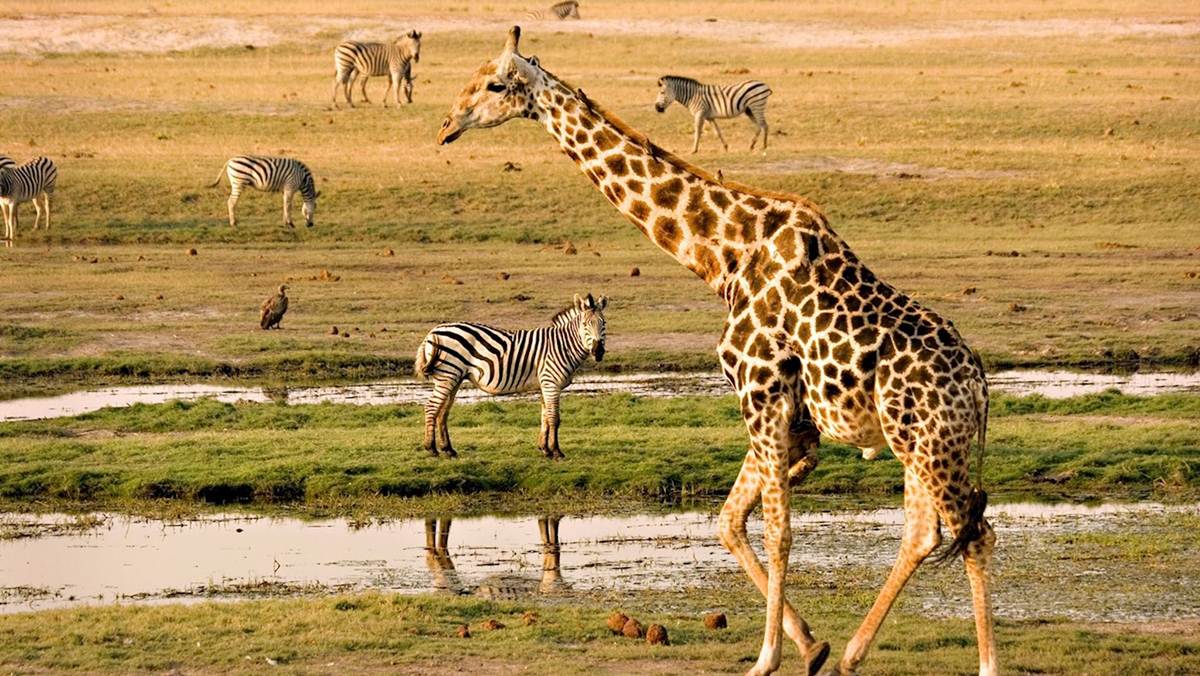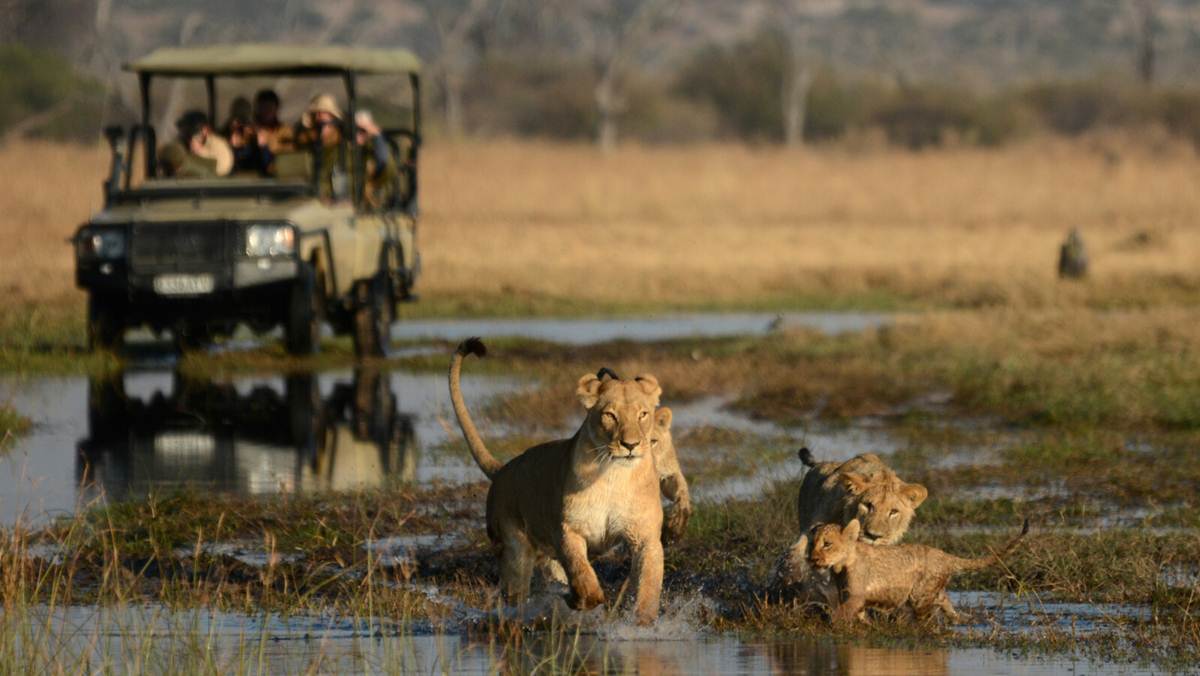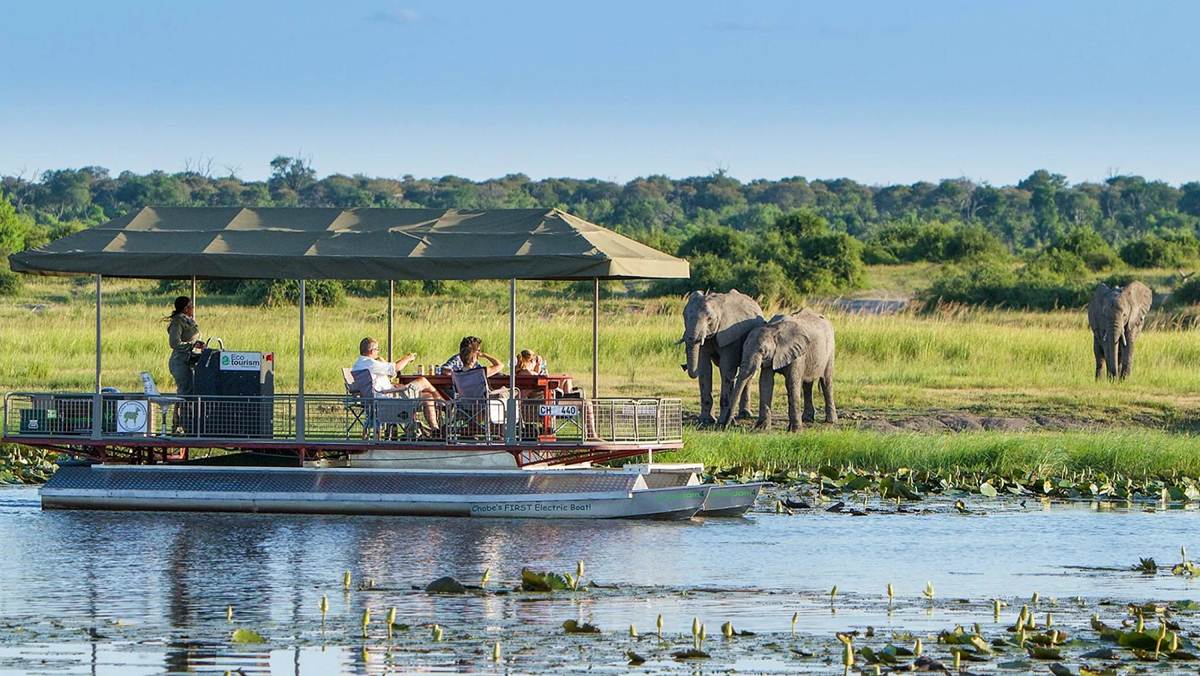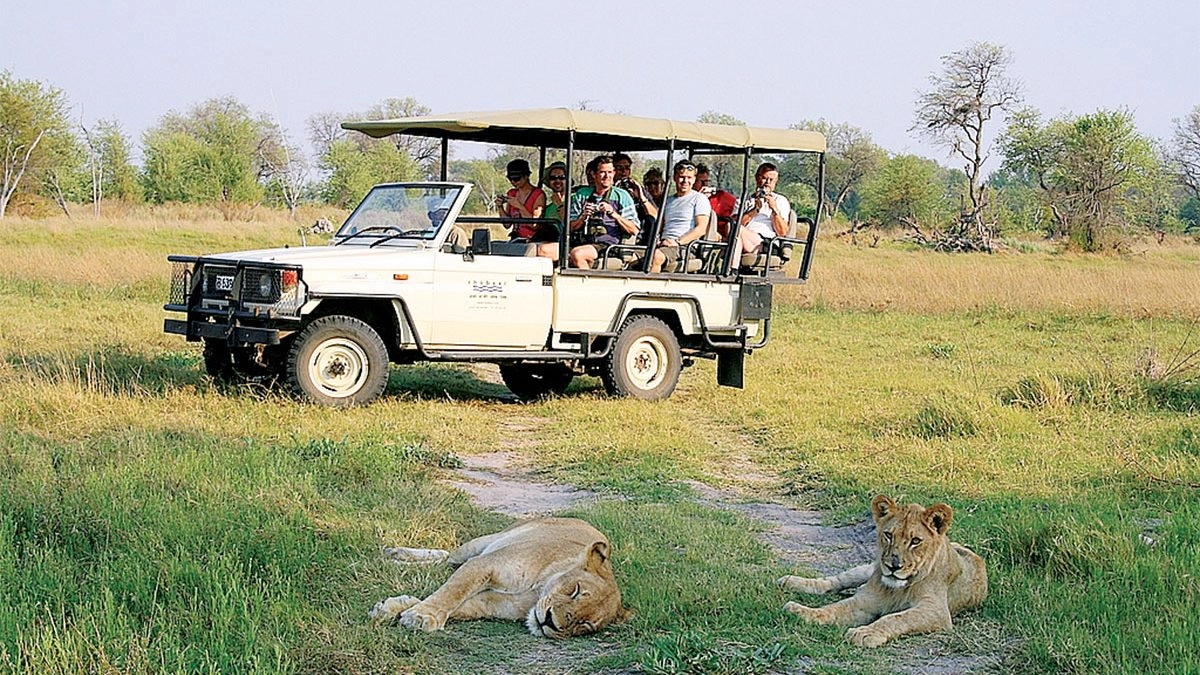Established in 1968, Chobe National Park covers approximately 11,700 sq km, encompassing floodplains, swamps and woodland. The Chobe River forms the park’s northern boundary, which includes four distinct geographical areas: the Chobe Riverfront: the Ngwezumba pans; Savuté; and Linyanti.
Whether arriving by air or road on Botswana tour, the first glimpse of the Chobe River is always breath-taking. It appears as a swathe of bright, blue ribbon, winding its way through the tiny town of Kasane and out into the Chobe National Park’s wilderness.
One of Africa’s most beautiful rivers, the Chobe, supports a diversity and concentration of wildlife unmatched in Botswana.
The most accessible and frequently visited of Botswana’s big game country, the Chobe Riverfront, is most famous for the large herds of elephants and Cape Buffalo that converge on the riverbank to drink during the dry winter months.

During this season, on an afternoon game drive, you may see hundreds of elephants at one time. The main Serondella Road sometimes becomes impassable as scores of family herds cross the main road to make their way to the river to drink, bathe and play.
Driving the tracks and trails close to the riverbank on your African safari in Botswana, you may see as many 15 different species of animals on any one drive when on Botswana safari.
Common species include waterbuck, lechwe, puku (endemic to this area), giraffe, kudu, roan and sable, impala, warthog, bushbuck, monkeys and baboons, along with the accompanying predators such as lion, leopard, hyena and jackal, who are never far away.
Take a river cruise – and you’ll experience the park and wildlife from a completely different vantage point, getting up closer to hippo, crocodile and a mind-boggling array of water birds than you ever would on land.
Over 460 bird species have been recorded in the park, making it one of Africa’s premier venues for bird safaris. Common species include the Sacred Ibis, Egyptian Geese, the ubiquitous cormorants and darters, Spur-winged Geese, Pel’s Fishing Owl, carmine Bee-eaters, most members of the kingfisher family, all the rollers, the unmistakable Fish Eagle, the Martial Eagle, and many members of the stork family.
The Chobe River rises in the northern Angolan highlands and travels vast distances before reaching Botswana at Ngoma.
Like the Okavango and Zambezi rivers, the Chobe’s course is affected by fault lines that are extensions of the Great Rift Valley. These three mighty rivers carry more water than all other Southern Africa rivers.
A little Bit about Chobe National Park
Stumble upon wildlife wherever you go in beautiful Botswana.
After driving a few metres along the impressive Chobe Riverfront, your guide on Chobe safari tour suddenly stops. An elephant family slowly wanders across the road, planning to take a bath.

As you gaze at this amazing scene, you can hear the dull sound of heavy feet in the sand, the breathing and whiffing, and occasional trumpeting from these beautiful, mighty creatures.
One of the most awe-inspiring safari experiences is the up-close and personal meetings with wildlife at Chobe National Park, and we can assure you will have them frequently during your visit. Welcome to the park with some of the highest game density in all of Africa.
Going on a Chobe Safari
Are you considering, or maybe even planning a trip to the Chobe National Park? Naturally, you want it to be the journey of a lifetime and it will be.
Why? There are not many places left in the world with such unspoilt nature splendor, wildlife and truly pampering lodges.
Before you are ready to grab your suitcases from the attic, we would like to provide a bit more background information – if only to stir the anticipation of going – and answer the questions you might have in the sections below.
When you visit the Chobe National Park, you will never forget the first glimpse of the dazzling, deep blue Chobe River, as it winds its way through sandy terrain, small towns, lush floodplains, dense forests of cathedral mopane trees, and endless broadleaf woodlands.
Chobe National Park is named after this majestic river that protects 10.700 km² of the northern Kalahari desert, providing ensuing wilderness and a game density that is steadily remarkable.
A place for everyone – Chobe National Park
Famed for its massive elephant populations, big herds of buffalo (matched only by some large lion prides) and incredible birdlife, Chobe National Park will leave an everlasting memory.
Where else can you find such an amazing riverfront, with bustling wildlife, undisturbed predators, heavenly landscapes and tranquil lodges? The most accessible area of the park is the Chobe Riverfront, this is also where you will find the largest concentration of wildlife.
For a more predator-rich area: head off to Linyanti Marshes. Or nourish your soul in the remote Savuti area. Wherever you go in this park, wildlife encounters are plentiful and all of Chobe feels like true wilderness. It is a place that can be enjoyed by everyone: couples, families and seasoned Africa travelers.
We will explain more about the different areas below. But first, a little bit about the history of this special place.
History of Chobe National Park
The original inhabitants of Chobe were the Bushmen, followed by the – impressively named – Hambukushu, Bayei and Basubiya.
In the 1850s, locals saw explorer David Livingstone passing through the area on his way to the Victoria Falls (a little over an hour away from Chobe National Park), and some big-game hunters seeking trophies and ivory.

Luckily, for all the flora and fauna of this unique land, the area was first protected as a game reserve in 1961 and proclaimed as national park in 1968.
Up to this day the game-density remains exceptional. You will be forced to halt frequently because a parade of wildlife wants to pass by. Much better than stopping for a red light in traffic, right? Moderating the number of visitors to the park keeps it from feeling ‘too busy’, adding to the remote and exclusive Chobe safari experience.
Flora and Fauna: Plenty of Different Areas in Chobe National Park
Whenever you are close to the Chobe river, you will notice a broad variety of lush green bushes and trees. Away from water sources, the bushes get thicker and thorny, with a few open areas.
Although Chobe National Park is a wildlife paradise, trying to describe it as a whole would be a mistake. Chobe consists of many different smaller ecosystems, each with its own vibe, different vegetation and animal population. We will explain more about the three areas here, but will try to give you an overview of what the park is about first.
Wildlife in Chobe National Park Around the Clock
You can encounter Chobe’s wildlife across the entire park. When the dry season begins, large herds of elephant and buffalo seek the permanent waters of the Chobe and Linyanti Rivers. Imagine thousands of them, coming sometimes all the way from Zimbabwe’s Hwange National Park.

All year round, Chobe’s big game includes zebra, impala, baboon, blue wildebeest, kudu, giraffe, warthog and vervet monkey. Lions and the spotted hyena are very common; together they are the dominant predators, bringing you spectacular encounters with big buffalo herds.
The riverfront is the hotspot to see hippo, crocodile and the slightly odd, leguvaan (the second longest lizard of Africa).
Although seen less, the incredible cheetah, leopard and Africa’s rare wild dog roam the Chobe area frequently. Your guide will keep an eye out for these unique animals: seeing them in their natural environment is an unforgettable experience.
If you are very lucky, you might even spot the rarely seen, white rhino. Reintroduced in Botswana in 2001, they are spreading gradually. So a wandering rhino might turn up!
Some Chobe safari lodges offer night drives on their own property; a very exciting and special trip. At night, the nocturnal animals emerge, such as bushbabies (adorable fluffy animals with big eyes), African wildcats and honey badgers.
A little extra about birds in Chobe
If there is one more thing that needs our special attention, it is the overwhelming birdlife in Chobe National Park. With over 450 birds species, there is no way we can list them all. So, here are a few highlights.
Hop on a boat for a river cruise and spot kingfishers, a high density of fish eagles and African skimmers. Stay on the lookout for bee-eaters, hamerkops and wire-tailed swallows. Also the borders of the islands and Chobe floodplains are where you want to be: storks, geese, herons and many, many plovers.
Unusual, but definitely worth seeking are the rufous bellied and white-backed night herons, with their long beaks and elegant crest.
Overall, even if you are not a birdwatcher, these frolicking feather bundles will steal your heart, right from the moment they appear in front of your binoculars.
Chobe National Park: A Botswana Family Safari Biggest Playground
Yes, planning a Chobe safari with the entire family can be challenging. But, if do it right, you and the little ones will have the experience of a lifetime. A few things to keep in mind: anticipation is a very important part of the overall trip.
Especially if it is the first time your kid(s) will venture out of their comfort zone: talking about it and viewing pictures of the animals helps them prepare. What will they see? Maybe they want to make a checklist of cool animals they want to spot? Involve them in Africa safari packing their suitcases too; if they feel a sense of responsibility, the trip will be more exciting.
Because the lodges in Chobe are all in the ‘true’ wilderness (unfenced), owners are quite strict with safety restrictions. Always check the minimum age permitted in the camp. Most camps also have a minimum age for game drives and guided bush walks.
Besides that, a Botswana safari is the perfect way to enhance family bonding (imagine reminiscing about the day under a star-studded sky, or waking up together with wildlife roaming in front of your suite), so start planning and let the anticipation begin!
Accommodation in Chobe National Park
Chobe National Park in Botswana is a huge game reserve and includes the Savute and Linyanti regions. However, most people refer to the region along the Chobe River in the north when they talk about the Chobe National Park.
Chobe offers many different accommodation options, both inside and outside the national park.
In the Chobe River area, there is only one permanent game lodge on the Chobe River inside the park – Chobe Game Lodge. A number of the more affordable safari lodges that are listed here are situated just outside the park, in the town of Kasane.
All game viewing by boat or by vehicle is done inside the Chobe National Park.
Chobe Savanna Lodge is situated opposite the park in Namibia, on the other side of the Chobe River, but is still listed here because the boat-based game viewing is done within the Chobe National Park.
There are also a number of mobile tented safari camps in the Chobe National Park which are not permanent. The selection of lodges below is not complete – there are many other camps and lodges in the greater Chobe region.
Chobe Game Lodge
Chobe Game Lodge sits on the banks of the Chobe River in Botswana’s diverse Chobe National Park and is the only permanent game lodge in this area. Its 44 rooms all overlook the Chobe River and Caprivi floodplain.
For those looking for ultimate exclusivity, there are four luxury suites, each with its own private plunge pool and viewing terrace. Chobe National Park is home to the largest concentration of elephants in Africa and offers spectacular game viewing all year round.
Chobe Marina Lodge
Chobe Marina Lodge is situated just outside the Chobe National Park in Kasane, Botswana. The lodge provides luxury accommodation with beautiful views over the Chobe River.
Chobe Marina Lodge offers a variety of activities, including open-vehicle game drives in the Chobe National Park, or game viewing by boat along the Chobe River, reputedly the best boat-based game viewing in the world.
This lodge is reasonably priced and can easily be combined with nearby Victoria Falls for an unforgettable safari.
Chobe Safari Lodge
Chobe Safari Lodge offers luxury, yet affordable, safari accommodation in the Chobe area, overlooking the Chobe River.
Situated in Kasane, Botswana, Chobe Safari Lodge is a large resort-style safari lodge bordering the Chobe National Park, which is famous for its excellent game viewing.
Chobe Savanna Lodge
Chobe Savanna Lodge is a luxury establishment overlooking the Chobe River in Namibia’s Eastern Caprivi.
The lodge offers spectacular views of the Chobe River and the vast floodplains of the Chobe National Park’s Puku Flats, with its abundance of wildlife.
Chobe Under Canvas
Chobe Under Canvas is an intimate, luxurious mobile tented camp in the northern half of the game-rich Chobe National Park in Botswana that provides guests with a unique and unforgettable safari experience. The six spacious tents accommodate a maximum of 12 guests.
Ghoha Hills Savuti Lodge
Sitting unobtrusively on a hillside overlooking the Savuti plains below, Ghoha Hills Savuti Lodge is an intimate, luxury lodge.
Completely solar-powered and designed to sit gently within its environment, you’ll enjoy unsurpassed 180-degree views over the game-rich surrounds.
Kubu Lodge
Kubu Lodge, situated on the banks of the Chobe River in Botswana, offers comfortable accommodation and is a gateway to the Chobe safari experience.
It’s located 2km from the meeting place of four countries: Botswana, Namibia, Zambia and Zimbabwe. Kubu Lodge offers excellent cuisine, various activities and rustic accommodation with panoramic views over the Chobe River.
Muchenje Lodge, set on an escarpment overlooking the Chobe River, is a popular safari destination with great views over the Chobe floodplain.
It is the only luxury lodge in the area west of the Chobe National Park, and offers fantastic open-vehicle game drives within the park.
Nogatsaa Pans Lodge
About 80km south of the Chobe River in Botswana lies Nogatsaa Pans Lodge. The area is studded with natural clay-bottom pans that provide plentiful water in summer, supplemented by boreholes during the winter months.
Idyllic and peaceful, there are raised hides at four waterholes for watching the fascinating inhabitants of this pristine
Savute Elephant Camp
Savute Elephant Camp is a luxury camp situated on the banks of the Savute channel. Previously, the channel was dry and the camp used to overlook an active waterhole.
Since 2009 the Savute channel has been flowing again and now the camp offers spectacular views over this veritable wildlife oasis in the heart of the Chobe National Park in Botswana. The game viewing is spectacular.
Savute Safari Lodge is a luxury lodge situated on the banks of the Savute River channel in Chobe National Park, Botswana. The lodge offers accommodation with magnificent views of the Savute Channel, great game viewing and birding all year round.
Known for its quality service and luxurious suites, Savute Safari Lodge will provide you with a uniquely African safari experience.






